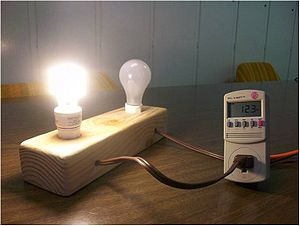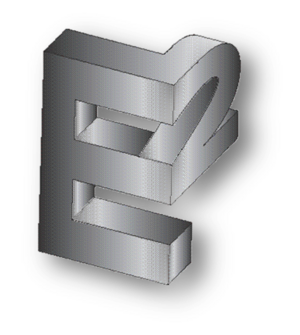

Redwood Coast Energy Authority (RCEA) asked the Spring 2010 Environmental Resources Engineering Intro to Design Class at Cal Poly Humboldt in Arcata, California to design educational kits. These kits provide teachers of Humboldt County the tools that are necessary to teach kindergarten through 12th grade students about climate change, renewable resources, or energy conservation. This webpage describes the project created by Team Esquared, Bust-A-Watt, which teaches fifth through eighth grade students about energy conservation

The RCEA is a Joint Powers Authority focused on implementing sustainible and renewable energy in Humboldt County.
At the beginning of the Spring 2010 semester they asked the Engineering 215 class at HSU to design educational kits that teach K-12 students about these energy topics. Team E2 of the Engineering 215 class was assigned to develop a kit that teaches fifth through eighth grade students about energy conservation. Over a 12 week period, Team E2; Elizabeth Gutierrez, Bryan Schmitt, and Logan Baumgartner, used the criteria they agreed upon with the RCEA to design and develop Bust-A-Watt; a five day comprehensive lesson plan that motivates and educates middle school students toward energy conservation.
Criteria[edit | edit source]
Criteria were created by team E2 as a tool to structure the final design. The criteria were created in correspondence with RCEA's standards and expectations, and with input by Humboldt County teachers. In addition to creating the criteria a weight was given to each. The weight is a scale created by E2 to decide the level of importance of each criteria. Table 1 shows each criteria, its weight, and a description of that criteria.
| Criteria | Weight | Description |
|---|---|---|
| Safety | 10 | Level of avoiding risk of injury and danger to any individual |
| Durability | 10 | Ability for the kit to last for at least a one year with normal use |
| Amount of Real World Applicability | 10 | Amount of information that students will gain from the kit which pretains to real world applications |
| Cost | 9 | Amount of money spent on the kit from E2 and RCEA |
| Level of Engagement | 8 | Kit's ability to create student interaction during implementation |
| Compliance with Educational Standards | 8 | How many California State Math and Science Standards the kit contains |
| Ease of Use | 7 | Amount of effort needed by teachers to implement kit into the classroom and by RCEA to maintain at their office |
| Transportability | 6 | Ability for the kit to be transported from RCEA to the classroom without damage to insturments |
Description of Final Project[edit | edit source]
Bust-A-Watt educates middle school students about energy conservation through hands on activities, interactive discussions, home assessment assignments, and a reflective art assignment. Bust-A-Watt is a weeklong energy conservation unit, broken up into five one hour class periods, or individual daily activities. Three of the days consist of class discussions and two days consist of experimental activities.
Day 1: Introduction[edit | edit source]
- Energy Conservation unit is introduced via lecture; why conserving energy is important, how energy is measured, and Home Checklist introduced.
- Discussion: Students are given a background of why conserving energy is important. The energy and power lecture consists of teaching students what watts, kilowatts, kilowatt hour, and joules are and how they relate to each other.
- Home Checklist is introduced: Students assess their own homes by completing a home checklist in which they consider the amount of appliances in their home and their amount of use.
Day 2: Blinding Heat[edit | edit source]
- Blinding Heat activity demonstrates to students what heat transfer and the Law of the Conservation of Energy are by using a hands-on activity.
- Students compare the wattage and temperature of a CFL and incandescent bulb over time using a Kill-A-WattTM meter, thermometer, and the docking station pictured in Figure 2.
- Students then make conclusions and graph their data to visualize comparison.
Day 3: Appliance Energy Reading[edit | edit source]
- The Appliance Energy Reading Activity shows students the amount of energy used by appliances while on and off.
- Students receive an activity sheet, a Kill-A-Watt™ meter, and an extension cord (if needed).
- Students then use the Kill-A-Watt™ meter to measure the energy use of appliances while on and off.
- Lastly, students use their data to draw conclusions and graph the energy use of each appliance while on and off.
Day 4: Blinding Heat Discussion[edit | edit source]
- Students discuss Blinding Heat results to motivate energy conservation in their homes.
- Blinding Heat results are used to teach California science and math standards.
- The students calculate with teacher how much energy and money can be saved if the class switches their incandescent bulbs to CFL bulbs.
Day 5: Reflection[edit | edit source]
- The Unit is concluded.
- Students discusse their Appliance Energy Reading results.
- Total class Home Checklist results.
- Individual appliance calculation results.
- Students reflect upon the unit by creating a poster displaying something they learned during the week.
Costs[edit | edit source]
The following tables respectively show the total expentitures by Team E2 and the expected cost per year for the RCEA to maintain the educational kit if it is implemented three times per year.
Table 1: Implementation Cost
| Item | Unit Cost ($) | Quantity | Item Cost ($) |
|---|---|---|---|
| Plug-To-Socket Adaptor Brown | 1.75 | 12 | 21.00 |
| Plug-To-Socket Adaptor Ivory | 1.89 | 4 | 7.56 |
| Ace Extension Cord 6ft | 1.99 | 14 | 27.86 |
| Ace Extension Cord 10ft | 4.49 | 7 | 31.43 |
| Ace 6 Outlet Power Center | 4.79 | 1 | 4.79 |
| 4"x4"x8' Fir Lumber Board | 9.01 | 1 | 9.01 |
| Kill-A-Watt Meter | 17.89 | 7 | 125.23 |
| Therometer | 1.90 | 7 | 13.33 |
| CFL Light Bulb | 1.25 | 8 | 10.00 |
| Incandescent Light Bulb | 1.50 | 7 | Donated |
| USB Drive | 8.00 | 1 | Donated |
| Paper | 0.01 | 280 | Donated |
| Total | $ 250.21 | ||
Table 2: Maintenance Cost
| Maintenance Task | Projected Number/per year | Cost/per year |
|---|---|---|
| Print paper assignments | 3 weekly lesson plans | $ 9.00 |
| Replacemant light bulb | 1 bulb | 1.50 |
| Replacement extension cord | 1 extension cord | 5.00 |
| Replacement thermometer | 2 thermometer | 4.00 |
| Total Maintenance Cost/per year | $ 19.50 |
Testing Results[edit | edit source]
Bust-A-Watt has been reviewed and edited by three local middle school and high school educators, the Redwood Coast Energy Authority employee Oliver Hulland, and Cal Poly Humboldt Environmental Resources Engineering Introduction to Design instructor Lonny Grafman throughout Bust-A-Watt's creation and production. These resources helped in the creation of Bust-A-Watt's criteria, as well as in the decision process, and in testing Bust-A-Watt in local middle school classrooms. During the week of April 19th Bust-A-Watt was implemented into a middle school science class at Laurel Tree Learning Center in Arcata, and on April 26th the Blinding Heat activity was implemented into a sixth grade science class at Washington Elementary School in Eureka. The testing results showed that discussions during the introduction of Bust-A-Watt did not fill the one hour block that was intended. The testing also revealed confusing aspects of the activity instructions which helped in editting them for testing at Washignton Elementary. After implementation at Laurel Tree Learning Center the students were given a short survey to fill out in which they were asked their favorite and least favorite parts of the lesson plan as well as which parts were confusing.
Discussion and next steps[edit | edit source]
The Bust-A-Watt educational kit was recieved well by the students at Laurel Tree Learning Center. They felt that the unit helped them learn about energy basics and energy conservation. Although the insturctions and discussions are geared toward middle school students, the kit could be implemented into high schools or even elementary schools with only small changes to the content of each discussion and lab sheet. The docking stations for Blinding Heat are incredibly durable; however, light bulbs are not. There is a possibility that a student may trip on an extension cord resulting in broken light bulbs and possible mercury exposure. Due to lack of resources and time team E2 was unable to install the proposed metal fencing cages around both light bulbs on each station to prevent the light bulbs from breaking. The thermometers are also another concern of team E2. Due to the budget of the project, two dollar thermometers were included in the box. These thermometers are rather fragile and can be broken by students easily; however they can be replaced easily.
Creators[edit | edit source]
Spring 2010 Engineering 215 Introduction to Design Team Esquared: